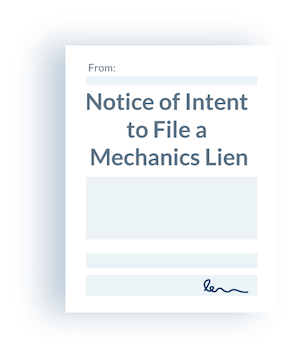
Do I Need A Notice, A Lien, Or Something Else?
For construction industry participants seeking to secure their lien rights to ensure payment, there is a generally-accepted, 3-step process that constitutes the “best practice.” Each step in the process includes a specific document: generally, the first step is sending a Preliminary Notice, followed by a Notice of Intent to Lien and then filing a Mechanics Lien.
If you are working on a project, or have already completed the project and are still waiting on payment, you might not know exactly where you are in the process, what document you need, and what options you have to facilitate payment.
Let’s dive a little deeper to help you best determine how to best proceed depending upon what stage the project you’re working on is at.
STAGE 1 I have yet to start the job, or I have just begun working
If you’re at or near the start of a new project and you find yourself working with a new client that you’ve never worked with before, on a project with a large contract value, or if you would just like to be first in line to get paid, STAGE 1 calls for a Preliminary Notice.
There’s an unfortunate, yet still widespread belief in the construction industry that sending a preliminary notice is somehow an adversarial gesture, or is an indication of non-payment, or even that it will lead to your customers to think that your firm is “difficult to work with.”
This misconception couldn’t be further from the truth. A preliminary notice is simply a document to state that you are a participant on this project. Sending this document benefits the property owner and any other parties up the food chain, as it alerts them to your company’s presence on the project which increases visibility.
Best practice is to always send this document as soon as the job starts, regardless of the state, your role, or the type of project you work on.
Do You Work in 1 of These States?
Does your construction company do business in:
- California
- Arizona
- Oregon
- Nevada
- Colorado
- Texas
- Tennessee
- Louisiana
If so, then this article is essential reading:
8 States With the Toughest Lien Notice Laws
STAGE 2 I am waiting on a progress payment, or I have completed my project and am waiting on final payment
While only 9 states require a Notice of Intent to Lien as part of the process to secure lien rights, a Notice of Intent to Lien happens to be a great tool in every state, regardless of whether it’s required or not.
Unlike the preliminary notice (which, as discussed above, is really a proactive, helpful document), a Notice of Intent to Lien is a really a demand letter, used to remind the client in a more forceful, insistent way that work has been successfully performed or completed, the payment is past due and has not been received.
In other words, the Notice of Intent to Lien is absolutely an indication of non-payment, and should only be sent when the potential threat of non-payment on a project looks like it could become real if steps are not taken.
The best time to send a Notice of Intent to Lien is well before the deadline to file a lien, when there is still plenty of time to work out the underlying payment issue fairly. In our over 10 years of experience managing the lien rights of every conceivable type of construction company in all 50 states, we have found that sending a Notice of Intent to Lien often prompts a delinquent customer to pay up without any further action required, since the threat of a potential mechanics lien filing is so great. We think of the Notice of Intent as a demand letter “with serious teeth.”
STAGE 3 My project was completed and I am chasing a delinquent payment
If you’ve successfully completed your work on a project, satisfying every aspect of the contract you have with your customer; if you proactively sent preliminary notice, then filed a Notice of Intent to Lien once payment became delinquent; if after all that you still haven’t received payment, then the step of last resort is to file a Mechanics Lien.
At this point in the process, there could be several reasons why your customer still hasn’t paid you. It might be a simple, careless error – they just forgot or are so disorganized that your invoice got lost in an avalanche of paperwork in a cluttered office somewhere. Or, your customer could be having real financial problems and can’t pay you because they don’t have the money. No matter the reason, you need leverage in order to get paid, and that’s exactly what filing a lien gives you.
When a mechanics lien is “filed,” it attaches to the underlying property, tying it up and giving the claimant tremendous leverage to prompt a payment. Filing a mechanics lien will escalate the situation and will make more project participants (especially the higher-tiered participants) aware of the debt owed to you. And if the lien filing doesn’t result in payment, then the claimant can file suit to enforce the lien, forcing a foreclosure on the property to settle the debt.
If you still have questions about construction payments, notices, lien and bond rights, and much more, please visit our 50 state resources page.
If you are ready to (or need to) send a document, you can give Levelset or head over to our pay-by-the-document filing service for assistance with preparing and sending your document.
There’s nothing worse than not getting paid money that you’ve rightly earned – that’s why Levelset exists. Get in touch with us, and let’s get you paid.



